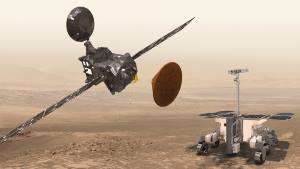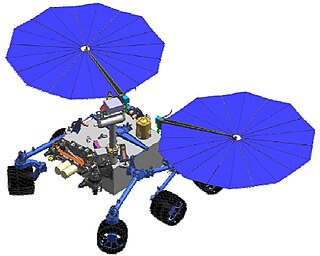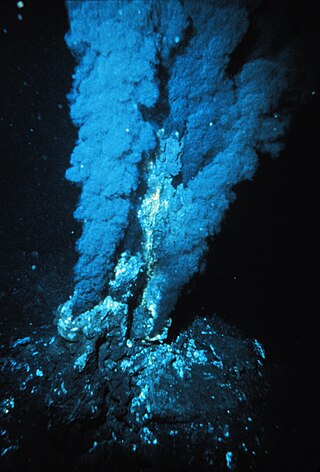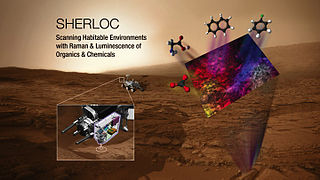
Astrobiology is a scientific field within the life and environmental sciences that studies the origins, early evolution, distribution, and future of life in the universe by investigating its deterministic conditions and contingent events. As a discipline, astrobiology is founded on the premise that life may exist beyond Earth.

The possibility of life on Mars is a subject of interest in astrobiology due to the planet's proximity and similarities to Earth. To date, no proof of past or present life has been found on Mars. Cumulative evidence suggests that during the ancient Noachian time period, the surface environment of Mars had liquid water and may have been habitable for microorganisms, but habitable conditions do not necessarily indicate life.
A biosignature is any substance – such as an element, isotope, molecule, or phenomenon that provides scientific evidence of past or present life. Measurable attributes of life include its complex physical or chemical structures and its use of free energy and the production of biomass and wastes. A biosignature can provide evidence for living organisms outside the Earth and can be directly or indirectly detected by searching for their unique byproducts.

In 1976 two identical Viking program landers each carried four types of biological experiments to the surface of Mars. The first successful Mars landers, Viking 1 and Viking 2, then carried out experiments to look for biosignatures of microbial life on Mars. The landers each used a robotic arm to pick up and place soil samples into sealed test containers on the craft.

ExoMars is an astrobiology programme of the European Space Agency (ESA) and the Russian space agency (Roscosmos).

The Mars Astrobiology Explorer-Cacher (MAX-C), also known as Mars 2018 mission, was a NASA concept for a Mars rover mission, proposed to be launched in 2018 together with the European ExoMars rover. The MAX-C rover concept was cancelled in April 2011 due to budget cuts.

Astrobiology Science and Technology for Exploring Planets (ASTEP) was a program established by NASA to sponsor research projects that advance the technology and techniques used in planetary exploration. The objective was to enable the study of astrobiology and to aid the planning of extraterrestrial exploration missions while prioritizing science, technology, and field campaigns.
Interplanetary contamination refers to biological contamination of a planetary body by a space probe or spacecraft, either deliberate or unintentional.
Rosalind Franklin, previously known as the ExoMars rover, is a planned robotic Mars rover, part of the international ExoMars programme led by the European Space Agency and the Russian Roscosmos State Corporation. The mission was scheduled to launch in July 2020, but was postponed to 2022. The 2022 Russian invasion of Ukraine has caused an indefinite delay of the programme, as the member states of the ESA voted to suspend the joint mission with Russia; in July 2022, ESA terminated its cooperation on the project with Russia. As of May 2022, the launch of the rover is not expected to occur before 2028 due to the need for a new non-Russian landing platform.
The Biological Oxidant and Life Detection (BOLD) is a concept mission to Mars focused on searching for evidence or biosignatures of microscopic life on Mars. The BOLD mission objective would be to quantify the amount of hydrogen peroxide existing in the Martian soil and to test for processes typically associated with life. Six landing packages are projected to impact 'softly' on Mars that include a limited power supply, a set of oxidant and life detection experiments, and a transmitter, which is able to transmit information via an existing Mars orbiter back to Earth. The mission was first proposed in 2012.

Curiosity is a car-sized Mars rover exploring Gale crater and Mount Sharp on Mars as part of NASA's Mars Science Laboratory (MSL) mission. Curiosity was launched from Cape Canaveral (CCAFS) on November 26, 2011, at 15:02:00 UTC and landed on Aeolis Palus inside Gale crater on Mars on August 6, 2012, 05:17:57 UTC. The Bradbury Landing site was less than 2.4 km (1.5 mi) from the center of the rover's touchdown target after a 560 million km (350 million mi) journey.
MELOS is a Japanese rover mission concept under study for an engineering demonstration of precision landing, and to look for possible biosignatures on Mars using a rover. JAXA has not published updates since 2015.

Icebreaker Life is a Mars lander mission concept proposed to NASA's Discovery Program. The mission involves a stationary lander that would be a near copy of the successful 2008 Phoenix and InSight spacecraft, but would carry an astrobiology scientific payload, including a drill to sample ice-cemented ground in the northern plains to conduct a search for biosignatures of current or past life on Mars.
ExoLance is a low-cost mission concept that could hitch a ride on other missions to Mars in an effort to look for evidence of subsurface life.

Planetary Instrument for X-Ray Lithochemistry (PIXL) is an X-ray fluorescence spectrometer to determine the fine scale elemental composition of Martian surface materials designed for the Perseverance rover as part of the Mars 2020 mission.

Scanning Habitable Environments with Raman and Luminescence for Organics and Chemicals (SHERLOC) is an ultraviolet Raman spectrometer that uses fine-scale imaging and an ultraviolet (UV) laser to determine fine-scale mineralogy, and detect organic compounds designed for the Perseverance rover as part of the Mars 2020 mission. It was constructed at the Jet Propulsion Laboratory with major subsystems being delivered from Malin Space Science Systems and Los Alamos National Laboratory. The Principal Investigator is Luther Beegle, and the Deputy Principal Investigator is Rohit Bhartia.
The Mars Organic Molecule Analyser (MOMA) is a mass spectrometer-based instrument on board the Rosalind Franklin rover to be launched in 2028 to Mars on an astrobiology mission. It will search for organic compounds in the collected soil samples. By characterizing the molecular structures of detected organics, MOMA can provide insights into potential molecular biosignatures. MOMA will be able to detect organic molecules at concentrations as low as 10 parts-per-billion by weight (ppbw). MOMA examines solid crushed samples exclusively; it does not perform atmospheric analyses.
ADRON-RM is a neutron spectrometer to search for subsurface water ice and hydrated minerals. This analyser is part of the science payload on board the European Space Agency'sRosalind Franklin rover, tasked to search for biosignatures and biomarkers on Mars. The rover is planned to be launched in August–October 2022 and land on Mars in spring 2023.
Signs Of LIfe Detector (SOLID) is an analytical instrument under development to detect extraterrestrial life in the form of organic biosignatures obtained from a core drill during planetary exploration.
Andrew Steele is an astrobiologist at the Geophysical Laboratory at Carnegie Institution for Science. He uses traditional and biotechnological approaches for the detection of microbial life in the field of astrobiology and Solar System exploration. His research has led to discoveries of new forms of carbon in meteorites, new mechanisms of organic synthesis on Earth and Mars, and the presence of water in lunar and Martian rocks. Steele has developed several instrument and mission concepts for future Mars missions and was involved in NASA’s 2011 Mars Science Laboratory mission, as a member of the Sample Analysis at Mars team. He also tested instruments on board the Arctic Mars Analogue Svalbard Expedition in the Arctic.












